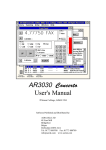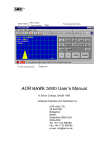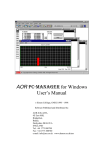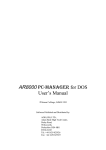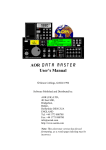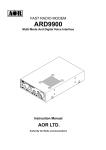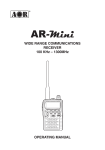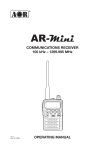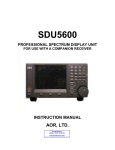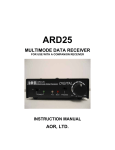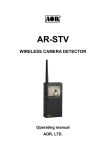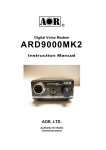Download AOR AR-3000A User`s manual
Transcript
AOR Searchlight User’s Manual © Simon Collings, G4SGI 1994~1999 Software and Manual Distributed by: AOR (UK) Ltd., 4E East Mill, Bridgefoot, Belper, Derbys DE56 2UA England Tel: 01773 880788 Int’l: +44 1773 880788 Fax: 01773 880780 Int’l: +44 1773 880780 e-mail: [email protected] www.demon.co.uk/aor CONTENTS CONTENTS INTRODUCTION ........................................................................................................... 1 ACKNOWLEDGEMENT ............................................................................................... 3 MINIMUM SYSTEM REQUIREMENTS ..................................................................... 4 INSTALLING THE PROGRAM ................................................................................... 5 GETTING STARTED ..................................................................................................... 9 RS-232 connection ................................................................................. ............ 9 Starting the Program ............................................................................................ 10 Configuring the program ..................................................................................... 11 The Front Panel Window .................................................................................... 12 Front Panel functions .......................................................................................... 13 Step Tuning .................................................................................................. 13 Tuning Step Size ........................................................................................... 13 User Step Size ............................................................................................... 13 VFO Offset ................................................................................................... 13 VFO Tracking ............................................................................................... 14 Attenuator ..................................................................................................... 14 Obtaining Help .................................................................................................... 14 MEMORY MENU FUNCTIONS ................................................................................... 17 New Bank ............................................................................................................ 18 Load Bank ........................................................................................................... 18 Memory Window functions ................................................................................. 19 Storing a memory channel ............................................................................ 19 Recalling a memory channel ........................................................................ 20 Editing a channel .......................................................................................... 20 Marking a channel ........................................................................................ 20 Sorting the memory bank ............................................................................. 21 Clearing a memory channel .......................................................................... 21 Save Bank ............................................................................................................ 21 Save Bank As ...................................................................................................... 21 Close Bank .......................................................................................................... 22 Delete Bank File .................................................................................................. 22 Print Bank ............................................................................................................ 22 Upload Bank from RX ......................................................................................... 23 Download Bank to RX ........................................................................................ 24 Copy Bank to Clipboard ...................................................................................... 24 Copy Bank from Clipboard ................................................................................. 25 Exit ....................................................................................................................... 25 SETUP MENU OPTIONS .............................................................................................. 26 Communications .................................................................................................. 26 Delays .................................................................................................................. 26 S-meter readings ........................................................................................... 27 Downloading ................................................................................................ 27 Uploading ..................................................................................................... 27 Tuning .......................................................................................................... 27 Sound Recording ................................................................................................. 28 Sample Rate Select .............................................................................................. 28 AOR Searchlight User’s Guide i CONTENTS SCANNING MENU OPTIONS .......................................................................................... Programmable Band Scan ...................................................................................... New PBS ................................................................................................................ x10 Magnify .................................................................................................... Setting the dwell time ...................................................................................... Saving PBS parameters ................................................................................... Creating a report .............................................................................................. Open PBS ............................................................................................................... Memory Scan ......................................................................................................... Use VFO A ...................................................................................................... Spectrum Analysis ................................................................................................. TOOLS MENU OPTIONS ................................................................................................ Offset Simplex Reconstruction .............................................................................. Setting the dwell time ..................................................................................... Single Frequency Watch ........................................................................................ Report synchronisation .................................................................................... Graphical Analysis ................................................................................................. Types of graph ................................................................................................. Delete Sound Log ................................................................................................... Print Sound Log ..................................................................................................... PASS LIST MENU OPTIONS ........................................................................................... Save ........................................................................................................................ Upload .................................................................................................................... Adding a frequency ......................................................................................... Deleting a frequency ....................................................................................... Sorting the pass list ......................................................................................... Editing an entry .............................................................................................. WINDOWS MENU OPTIONS .......................................................................................... Arrange Icons ......................................................................................................... SOUND RECORDING ....................................................................................................... Sound Log Window ............................................................................................... MEMORY DATA IN WINDOWSTM CLIPBOARD ........................................................ AOR Searchlight User’s Guide ii 30 30 30 31 32 32 32 33 33 34 35 37 37 38 38 39 40 41 41 41 42 42 42 43 43 43 43 45 45 46 47 49 INTRODUCTION INTRODUCTION Welcome to AOR Searchlight, the control program for Microsoft® WindowsTM and AOR communications receivers. This program uses an RS-232 serial port to tune an AOR AR-3000A or AR-3000 communications receiver and has these (and many more) exciting features: F Microsoft® WindowsTM program. AOR Searchlight is a genuine WindowsTM program (not a DOS program running in a window) and uses Microsoft’s Multiple Document Interface (MDI) and Common User Access (CUA) specifications for ease of use and a standard “look and feel”. F Full support for WindowsTM Sound Recording. This program (optionally) uses the sound recording facilities of WindowsTM Multimedia extensions. You can record audio from your radio using your WindowsTM compatible sound card while scanning or analysing frequencies. A log contains all the recordings you have made so you can replay them later. F On-line context sensitive help. The full WindowsTM hypertext help system is used to provide you with the information you need wherever you are in AOR Searchlight. In addition to the help menu, all dialogs have a “help” push button which calls up information for that dialog. You can also highlight individual menu options using the arrow keys and obtain help on them by pressing <F1>. F Unlimited number of disk based memory banks. Each memory bank contains 400 memory channels and can be uploaded from the radio or downloaded to the radio. Up to 10 can be viewed on-screen at once, an unlimited number can be stored on disk. F Upgrade your DOS based AORSC memory files. You can import your existing AOR Spectrum Coordinator (AORSC) memory files into the AOR Searchlight using a simple utility provided as standard. F Copy data to/from clipboard. You can exchange memory data with WindowsTM Clipboard for bulk editing and export to a data base (not supplied) or other WindowsTM applications. F Memory scan and Programmable Band Scan. Each scan provides a histogram display showing the activity on each channel. Full control is provided including a cursor indicator and sound recording (optional). AOR Searchlight User’s Guide 1 INTRODUCTION F Single Frequency Watch. This includes graphical analysis showing full statistics compiled as the SFW is in progress and includes text based reports and a log file. F Spectrum analysis. A fully featured spectrum analyser display is provided which allows you to review signals using cursor operated tuning. You can have the results of several spectrum analyses available on-screen at once. AOR Searchlight User’s Guide 2 ACKNOWLEDGEMENT ACKNOWLEDGEMENT AOR Searchlight has been developed over a year using the Borland Turbo Pascal for WindowsTM development system. The result is a genuine WindowsTM program, not a DOS program running inside a window. AOR Searchlight is a substantial program offering a comprehensive range of facilities that may take a while to fully explore (there are nearly 17000 lines of source code in the main program). This package takes radio control software forward to new standards of performance and adds features never offered before. It would not have been possible to complete this undertaking without the considerable help and support from AOR (UK) Ltd. I would like to thank AOR (UK) Ltd, and in particular Richard Hillier, for the support and feedback provided during the development of AOR Searchlight and for the generous loan of radio equipment. Simon Collings, G4SGI December 1993 AOR Searchlight User’s Guide 3 MINIMUM SYSTEM REQUIREMENTS MINIMUM SYSTEM REQUIREMENTS F 25 MHz 80386 IBM PC compatible or above F 4 Mbytes of memory or more F Microsoft® mouse F at least two RS-232 serial ports (one for mouse) F 2 Mbytes of free disk space F Microsoft® WindowsTM 3.1 (or higher) or Microsoft® Windows for Workgroups 3.1 (or higher) running in enhanced mode F Printer (optional) F Optional WindowsTM multimedia compatible sound card (eg Creative Labs Sound BlasterTM 2.0 or compatible). This is highly recommended. F An AOR AR-3000A or AR-3000 communications receiver AOR Searchlight User’s Guide 4 INSTALLING THE PROGRAM INSTALLING THE PROGRAM In these instructions, it is assumed that you are familiar with the way WindowsTM works, so there are few details included about using WindowsTM itself. If you need more information, you should consult your WindowsTM User’s Guide or run the WindowsTM tutorial that is available from program manager (under the Help|Windows Tutorial menu option). You should install and use AOR Searchlight using Microsoft® WindowsTM in enhanced mode. If you already have WindowsTM in enhanced mode (this is the default), you can proceed. If not, consult your WindowsTM User’s Guide to find out how to configure WindowsTM for enhanced mode. You must have Microsoft® WindowsTM running in enhanced mode for AOR Searchlight to run. To install AOR Searchlight, start WindowsTM (usually by typing “WIN <ENTER> at the DOS prompt) and bring the program manager window to the top so that you can see it clearly. There are two simple ways to install AOR Searchlight. First insert the distribution disk into drive A then... Either... Click on the File menu of program manger and select the Run... option. Type “A:\INSTALL.EXE<ENTER>” into the dialog. Or... Use file manager to list the files on drive A and double-click on the line with “INSTALL.EXE” on it. Either method can be used, but you should obtain the window shown below on your screen: AOR Searchlight User’s Guide 5 INSTALLING THE PROGRAM Two push buttons are provided inside the window. You can abort the installation by clicking on the “Quit” push button (or by pressing <Q>). Alternatively, to decompress and copy the program files onto your hard disk, click on the “Install...” push button (or press <I>). If you want to obtain help on the installation program, you can click on the Help menu option in the top right hand corner of the window. If you are proceeding with the installation, you will now be asked to type in the name of a directory on your hard disk for the program files (you will need approximately 2 MByte of space). The default directory name is “C:\SEARCH”, but you can change it by typing in an alternative into the dialog that is displayed. The dialog looks like that shown above. If you want to keep the default directory for the AOR Searchlight files, just click on the OK push button. If you want to change it, you can type in an alternative name and then click on OK (if the directory does not already exist, it will be created). Once you have selected a directory for the AOR Searchlight files, they are decompressed and copied onto your system in a few moments. AOR Searchlight User’s Guide 6 INSTALLING THE PROGRAM NOTE: The installation program does not alter your WindowsTM “.INI” initial settings files; it uses its own. The file is called “SEARCH.INI” and is located in the AOR Searchlight directory. The installation program creates a new group in program manager and adds the AOR Searchlight icons to it. The program group contains all the items you need to use the package and looks like: Where each icon is as follows: The main AOR Searchlight program An invitation to send us your comments Some useful guidance on RS-232 interfacing The AOR Spectrum Coordinator (AORSC) memory upgrade utility The “READ.ME” file AOR Searchlight User’s Guide 7 INSTALLING THE PROGRAM At the end of the installation process the new program group will be displayed in program manager. You can re-size the AOR Searchlight group window or minimise it if you wish. When the installation procedure is finished you are ready to connect your radio and start using the software. AOR Searchlight User’s Guide 8 GETTING STARTED GETTING STARTED RS-232 connection You must connect your radio to an RS-232 port of your computer before you can operate the software. A screened cable with 5 conductors is required for connecting the PC to the receiver. If you have previously been using the DOS program AOR Spectrum Coordinator (AORSC), you can use the same cable. If screened cable is not used then digital noise may radiate from the conductors of the cable and cause interference to reception. All cable connections should be high quality for durability. Configure the serial cable according to the diagram given below: PC 25w Female SHIELD TXD RXD RTS CTS GND 1 2 3 4 5 7 Radio 25w Male ————————————— ————————————— ————————————— ————————————— ————————————— ————————————— 6, 8-25 Not Connected 1 2 3 4 5 7 6, 8-25 Not Connected If you are using an AR-3000, pin 1 and pin 7 must be shorted together at the radio’s end of the cable. The cable should be one-to-one (as shown) for the AR-3000A. If you are using a 9-way connector, please refer to your computer manual for details of the pin connections (this may vary between manufacturers). One possible pinout is listed below (this is for the PTI-209 I/O card, which is quite common): AOR Searchlight User’s Guide 9 GETTING STARTED PC 9w Female 3 2 7 8 5 Radio 25w Male ————————————— ————————————— ————————————— ————————————— ————————————— 2 3 4 5 7 GND / SHIELD You should match the pin numbers for the PC 25w D-Type (female) in the table to those for your 9-way connector and make the cable accordingly. To check operation of the RS-232 connection between the radio and your PC, you can use WindowsTM Terminal to type in commands manually (AR-3000A owners only). Please read section 6.6 of your AR-3000A Instruction Manual for suitable commands. A configuration file for Terminal, called “RADIO.TRM”, is located in your AOR Searchlight directory (it sets up Terminal for 4800 baud on COM1). You can pick up this configuration file by selecting it from the File|Open... menu option of WindowsTM Terminal then use this standard WindowsTM utility to test the cable connection. You may need to alter the configuration if you are using slightly different RS-232 settings. If so, select the Settings|Communications... menu option of WindowsTM Terminal to alter the serial port parameters. Starting the program Before starting the program, please read the “READ.ME” file for last minute information or changes not covered by this manual. This is accessible from the AOR Searchlight program group; you just need to double-click on the “READ ME FIRST!” icon. To start AOR Searchlight, first run WindowsTM (if it is not already running), switch on your radio then check your RS-232 cable is connected properly and switch “ON” the remote RS-232 switch on the rear panel of the radio (AR-3000A owners only). AOR Searchlight User’s Guide 10 GETTING STARTED Remote switch Now open the AOR Searchlight group using program manager and double-click on the main program icon (which looks like an AOR radio). The program will then launch and display a copyright notice before opening it’s main window if all is well. The software should tune the radio to 145.5 MHz FMN as default. If your radio does not tune to 145.5 MHz, it may be because you have not configured AOR Searchlight for the right serial port or baud rate. Configuring the program To check the configuration of the program, select the Setup|Communications menu option and choose the options you require from the dialog that is displayed (see below): You can choose: the type of radio you are using (either AR-3000 or AR-3000A); the speed of RS-232 communications; the serial port. Make sure all these settings match your hardware. In the dialog above, AOR Searchlight has been setup for 4800 baud to an AR-3000A connected via serial port COM2. AOR Searchlight User’s Guide 11 GETTING STARTED AOR Searchlight will store these settings, for use next time the program is run, in the “SEARCH.INI” initial setting file which is maintained automatically by the program. Correct operation of the software is only guaranteed at 4800 baud The Front Panel Window Once you have the program running and properly configured, you can check that your radio and computer are working correctly using the front panel window. This contains a dual VFO display and an array of manually controls for tuning the radio. The front panel window looks like: You can select VFO A or VFO B using the A and B push buttons. To tune the radio to a specific frequency, click the numeric push buttons in the bottom right corner of the window (C clears and ENT is enter). The mode can be selected using the group of six radio buttons located in the box below the frequency display (just click on the mode you want so that there is a dot inside the circle). Example: To tune to 93 MHz FMW Click on 9, 3, ENT and select the correct mode by clicking on the FMW radio button with your mouse AOR Searchlight User’s Guide 12 GETTING STARTED If the front panel window is focused (highlighted) it will also respond to keyboard commands. Example: To tune to 90.8 MHz Press <9>, <0>, <.>, <8>, <ENTER>. You must select the mode using your mouse. Front Panel functions Step Tuning You can tune up or down in steps using the UP and DN push buttons. The current step size is shown in the box in the bottom left hand corner of the window. Tuning Step Size To alter the tuning step size, click on the + and - push buttons. User Step Size If none of the step sizes already provided are suitable, you can enter your own using the U-Step push button. Type in the step size you want (in kHz). Example: To enter a user step size of 6.25 kHz Type “6.25 <ENTER>” and click on OK. VFO Offset You can offset VFO A and B by a fixed amount. After clicking on the Offset push button, the following dialog is opened: AOR Searchlight User’s Guide 13 GETTING STARTED Enter an offset (in kHz) and click on OK. If the offset is negative, VFO B is offset below VFO A. If positive, VFO B is above VFO A. NOTE: The VFO offset function is intended to be used in association with VFO tracking. VFO Tracking VFO tracking allows you to link the two VFOs together so that the offset between them kept is constant. Click on the TRACKING check box so that there is a cross in the box to switch on VFO tracking. Attenuator Click on the ATTENUATOR check box to toggle the radio’s attenuator. The attenuator is on when there is a cross in the check box. Obtaining Help There is extensive help information available at all times throughout AOR Searchlight. There is a help push button in most dialogs which gives you full context sensitive help, or you can get help from the menu along the top of the AOR Searchlight window. NOTE: Specific help on using WindowsTM Help can be obtained by selecting the Help|Using Help menu option from within AOR Searchlight. Once you are running WindowsTM Help, you can read instructions for each feature of the program as you go along. A full list of the main features of AOR Searchlight is available from the Help menu of the program. All you need to do is select the option you need from the menu and read the contents of the help window that appears. AOR Searchlight User’s Guide 14 GETTING STARTED The topics that are available from the Help menu are shown below: The index contains a complete list of all the main help topics that are available. You can obtain help on any of the topics listed by selecting them with the mouse. Alternatively, you can list and search for information on topics using the search facility of WindowsTM Help (by clicking on the “Search” push button once WindowsTM Help is running). You can also obtain information about individual AOR Searchlight menu functions by highlighting them with the arrow keys and pressing <F1>. AOR Searchlight User’s Guide 15 GETTING STARTED Example: To find help on the Memory|Close Bank option First select the Memory menu, then press <Up> and <Dn> to highlight the Close bank option of the Memory menu... ...now press <F1> to obtain help on Memory|Close bank. AOR Searchlight User’s Guide 16 MEMORY MENU OPTIONS MEMORY MENU OPTIONS Memory data is organised by AOR Searchlight into banks of 400 channels. Each bank is stored on disk in a file and is displayed on-screen inside a window. Up to ten banks can be loaded into the program at once; there is no limit to the number of memory bank files that can be saved on disk (disk space permitting). When you start AOR Searchlight for the first time, no memory banks are displayed but you will be able to create a new (blank) bank using the Memory|New menu option. To create a new bank, click your mouse on the Memory menu (in the top left hand corner of the AOR Searchlight window). You should see the following Memory menu options: Some of the menu items are “greyed” out. This happens throughout AOR Searchlight when options are not available. In the example above only options that allow you to create or load a memory bank are enabled because there are no banks already open (eg it does not make sense to print a memory bank if there are none to print). NOTE: Most Memory menu options only operate on focused (highlighted) memory bank windows (eg when you select print, AOR Searchlight will print the focused memory bank window). AOR Searchlight User’s Guide 17 MEMORY MENU OPTIONS New Bank To create a new (blank) memory bank, click on the New Bank menu option. You will see a memory bank window appear on screen inside the main AOR Searchlight window. The whole program window will look similar to: The lines inside the window indicate blank data. When you start using the memory bank, memory channel data will be listed neatly inside the memory window in the form of a table. Load Bank Choose this Memory menu option if you have a memory bank file on disk which you want to load into AOR Searchlight. The following picture shows a memory bank window that has been loaded into the program. Note that the name of the memory bank file is displayed in the window’s title bar. You can also see a row of six push buttons along the top of the memory bank window. These provide you with the facilities you need to manipulate memory channels in the window. NOTE: Most of these push buttons only operate on a memory channel highlighted using the mouse. To highlight a channel, click on the required channel then use the push button function. AOR Searchlight User’s Guide 18 MEMORY MENU OPTIONS Store... Recall Edit... Mark Sort... Clear Add the current VFO to the highlighted channel Transfer the highlighted memory channel to the VFO Edit the highlighted memory channel data Toggle a * which indicates if the channel is included in a memory scan Sort the entire list of memory data Blank the highlighted memory channel Memory Window functions Storing a memory channel First select a memory channel inside the memory bank window. Now click on the Store... push button to open the following dialog: The frequencies in VFO A and VFO B are copied automatically into the dialog, you just need to type in an optional comment and click on the OK push button. AOR Searchlight User’s Guide 19 MEMORY MENU OPTIONS NOTE: The Mark check box is checked by default. If you do not want to include the channel in memory scans, you should uncheck the box (as shown above). Recalling a memory channel Select a memory channel (as above) and click on the Recall push button to transfer the memory data to the VFO. An alternative way to recall a memory channel is to double-click on the line where it is listed in the memory bank window. Editing a channel Select a memory channel in the normal way (by single-clicking on the required channel inside the memory bank window). Now click on the Edit... push button to alter the data in the memory channel using the following dialog: All the data in the selected memory channel is copied into the dialog so that you can edit it. Click on the OK push button to update the channel. Marking a channel The selected memory channel can be marked (a * appears in it’s listing in the memory bank window). When the * is present, the memory channel will be included in memory scans (only marked channels are included). To mark a memory channel, you can select it (by clicking once on it’s line inside the memory window) then click on the Mark push button. Alternatively, you can edit the channel to alter the mark. AOR Searchlight User’s Guide 20 MEMORY MENU OPTIONS NOTE: Memory channels are marked by default when storing, uploading or are added by a programmable band scan. Sorting the memory bank Use this push button to sort the memory channels listed in the memory bank window according to the frequency in VFO A, the mode in VFO A or the mark indicator. The following dialog is opened when you click on the Sort... push button: Select the type of sort you want using the radio buttons and click on the OK push button. Clearing a memory channel You cannot recover memory data after it has been cleared! You can clear a selected memory channel (blank it) using this push button. You can minimise the memory bank window so that it is reduced to an icon along the bottom of the main AOR Searchlight window using the push buttons in the top right hand corner of the window. Save Bank You can save the focused (highlighted) memory bank to disk using this option. However, if you have altered a memory bank and try to exit from AOR Searchlight, you will be asked if you want to save the data first. AOR Searchlight User’s Guide 21 MEMORY MENU OPTIONS Save Bank As Use this memory menu option to save the focused (highlighted) memory bank under a different name to that displayed on it’s title bar. NOTE: The file extension for the memory bank file must be “.MEM”! A WindowsTM standard dialog is used to let you type in the new filename. You can type in the name of the file you want in the File Name field of the dialog. Close Bank This option closes the focused (highlighted) memory bank window. You will need to use the Load Bank option to re-load the memory bank if you want to continue to use the data. Delete Bank File You cannot recover memory bank data once it has been deleted from disk! This option allows you to close the focused (highlighted) memory bank and delete it’s file from your hard disk. Print Bank Use this option to print a listing of the memory channels in the focused (highlighted) memory bank. AOR Searchlight User’s Guide 22 MEMORY MENU OPTIONS A WindowsTM standard dialog is used to control printing: Upload Bank from RX This option creates a new (blank) memory bank and uploads memory channel data from your radio into it. A simple progress dialog shows you how much of the upload has taken place so far. The upload may take several minutes. The AOR Searchlight main program window should look similar to: AOR Searchlight User’s Guide 23 MEMORY MENU OPTIONS THE TIMING OF RS-232 COMMANDS USED FOR UPLOADING DATA FROM THE RADIO IS CRITICAL. IT IS VITAL THAT NO OTHER PROGRAMS YOU MAY BE RUNNING INTERFERE WITH THE UPLOAD OR DATA MAY BE LOST. THE BEST WAY TO AVOID OTHER PROGRAMS INTERFERING WITH THE UPLOAD IS TO STOP THEM AND RUN AOR SEARCHLIGHT IN THE FOREGROUND. Download Bank to RX Existing data in the radio will be overwritten by this option! This option downloads memory data (VFO A only) from the focused memory bank to your radio. A simple progress indicator, similar to that for uploading, is also displayed as the download takes place. The download may take a couple of minutes. THE TIMING OF RS-232 COMMANDS USED FOR DOWNLOADING DATA TO THE RADIO IS CRITICAL. IT IS VITAL THAT NO OTHER PROGRAMS YOU MAY BE RUNNING INTERFERE WITH THE DOWNLOAD OR DATA MAY BE LOST. THE BEST WAY TO AVOID OTHER PROGRAMS INTERFERING WITH THE DOWNLOAD IS TO STOP THEM AND RUN AOR SEARCHLIGHT IN THE FOREGROUND. Copy Bank to Clipboard Data from the currently focused memory bank can be copied as text to WindowsTM Clipboard where it can be transferred to other applications. Using this option, it is possible to modify memory data in bulk using a text editor (eg WindowsTM Notepad) then copy it back into Clipboard so that it can be transferred back to AOR Searchlight. NOTE: Read the section called MEMORY DATA IN WINDOWSTM CLIPBOARD for a description of the text format used when copying to/from Clipboard. AOR Searchlight User’s Guide 24 MEMORY MENU OPTIONS Copy Bank from Clipboard This memory menu option allows you to copy data back from WindowsTM Clipboard into the currently focused memory bank. This facility complements copying to Clipboard. Any occupied memory channels in the focused memory bank will be overwritten if they are also in the Clipboard data. Create a new (blank) memory bank using the Memory|New menu option to copy memory bank data without overwriting. NOTE: Read the section called MEMORY DATA IN WINDOWSTM CLIPBOARD for a description of the text format used when copying to/from Clipboard. Exit This option allows you to exit from AOR Searchlight, you can also double-click on the system menu bar of the main program window. AOR Searchlight User’s Guide 25 SETUP MENU OPTIONS SETUP MENU OPTIONS The Setup menu options allow you to configure AOR Searchlight so that it runs correctly with your hardware. The four options that are provided are: Communications The communications options relate to the RS-232 serial port settings for your computer and have already been described in the GETTING STARTED section. Delays When RS-232 communications take place with your radio, they must be slowed down so that the radio can process commands properly. AOR Searchlight uses WindowsTM timers to moderate the flow of commands between your computer and radio. The following dialog, which allows you to alter the delays used, is opened when you select Setup|Delays...: The four delays are: S-meter readings; Tuning commands; Downloading; Uploading. There is a scroll bar and a box indicating the current delay value (in milliseconds) for each delay type. AOR Searchlight User’s Guide 26 SETUP MENU OPTIONS S-meter readings This is the delay between S-meter commands being sent to the radio and the program attempting to read the signal level. It gives the radio time to obtain the S-meter reading. Downloading This is the period of time between download commands and gives the radio time to add previous data to local memory before the next arrives. Uploading This is the period of time between upload commands and allows the radio time to prepare memory data for output to the computer. Tuning This is the delay between tuning commands and lets the radio finish tuning before the next command arrives. In all cases, you probably do not need to alter the default values that are provided. If you have problems with frequencies being missed or data being corrupted during uploading/ downloading operations, try altering the delay settings. You should try very small changes at first, usually by increasing the delays. The setting of these delays can be very sensitive. If you do need to change them, you may need to experiment very carefully with a number of settings. First make sure you are adjusting the right control, then slowly alter it’s setting in very small steps until the problem goes away. If you want to restore the current default values before closing the dialog, click on the Default push button. AOR Searchlight User’s Guide 27 SETUP MENU OPTIONS Sound Recording Further details of the requirements for sound recording are given in the SOUND RECORDING section. NOTE: This setup menu option is greyed out if you do not have a sound card and suitable MCI driver installed on your system. If you have a WindowsTM compatible sound card fitted, you can use the sound recording facilities of AOR Searchlight. Many functions of the program let you record up to 60 seconds of audio and make automatic entries in a sound log. The maximum time limit has been carefully chosen to prevent your hard disk being filled up quickly while allowing the most useful parts of transmissions to be recorded. You can open the following dialog using the Setup|Sound Recording menu option or by clicking on the Sound... push button inside other selected dialogs: To adjust the maximum recording time, use the scroll bar to obtain the required period of time in the box on the right. Sound recording is not enabled until you have checked the Enable Sound Recording check box. Sample Rate Select Further details of the requirements for sound recording are given in the SOUND RECORDING section. NOTE: This setup menu option is greyed out if you do not have a sound card and suitable MCI driver installed on your system. Sound recording involves setting up your sound card’s sample rate and number of bits per sample. The most efficient sample rate for communications quality audio from your radio is 8 kHz (giving a 4 kHz bandwidth) with 8-bit resolution. This combination provides fairly low quality reproduction compared with higher rates, but uses the least amount of disk space. AOR Searchlight User’s Guide 28 SETUP MENU OPTIONS Not all WindowsTM compatible cards support 8 kHz sampling at 8-bits since this is not a standard WindowsTM format, but it is included with AOR Searchlight as an option. If you want to use this compact sound recording format, use the Setup|Sample Rate Select option to open the following dialog: Select the format you want using the radio buttons provided in the dialog. The default for your card is normally 11.025 kHz or 22.050 kHz depending on it’s specification. You can test your sound card using the Rec button inside the sound log window. If the log refuses to record audio, your card does not support this special setting. NOTE: You may be able to obtain an update to the driver for your sound card, which will support 8 kHz 8-bit sampling, by contacting the vendor you obtained the card from. AOR Searchlight User’s Guide 29 SCANNING MENU OPTIONS SCANNING MENU OPTIONS A number of scanning functions are provided by the Scanning menu. The options are shown below: Programmable Band Scan A programmable band scan lets you scan the radio between two specific frequency limits. New active frequencies are added to a memory bank as they are found. You can even add recordings of the signals into the sound log. New PBS The New PBS option allows you to setup a programmable band scan from scratch. When you select Scanning|New PBS, the following dialog is opened: Enter the frequency limits you want, select the tuning step size and mode then click on OK. If you want to use sound recording, click on the Sound... push button to open the sound recording setup dialog (described elsewhere). You must choose frequencies for each band edge that are covered by the radio and are different from each other. AOR Searchlight User’s Guide 30 SCANNING MENU OPTIONS Once the PBS has started, a programmable band scan window and a new (blank) memory bank window are opened. Your main AOR Searchlight window should look similar to: As new frequencies are found, they are added to the memory bank. If you selected sound recording, the transmissions are also added to the sound log. A histogram display is provided in the centre of the window. This shows graphically what level of activity has been detected on each frequency found. You can click on the histogram display to position a cursor and monitor data for a particular channel. The cursor data appears in the box at the bottom of the window. x10 Magnify A check box lets you change the vertical scale of the histogram display. When unchecked the scale is 0-100%, when checked it is 0-10%. The programmable band scan window has the following push buttons: Abort Exit Pass Dwell... Pause... Stop Print Save... Report Exit from the PBS and restore the VFO Exit from the PBS and copy the last scanned frequency to the VFO Add the current scanned frequency to the pass list to exclude it from the scan Set the period of time spent on active frequencies Pause the scan Stop scanning, do not destroy the PBS window Print the PBS histogram Save the PBS parameters Save a text report of activity observed during the scan AOR Searchlight User’s Guide 31 SCANNING MENU OPTIONS If you stop the PBS, the programmable band scan window stays open and you can then use the cursor to review channels. The radio is also tuned when you select each channel using the cursor. Setting the dwell time The dwell time is the period of time spent on a frequency when activity is present. Scanning resumes again after the dwell time has expired. When you click on the Dwell... push button, the following dialog is opened: Use the scroll bar to set the length of time the scan dwells on each active channel. The value you select is shown inside the box. Saving PBS parameters The Save... push button opens a standard WindowsTM dialog that allows you to save the parameters of the programmable band scan in a file. You should choose a filename with the “.PBS” extension. Creating a report Reports are text files which contain details of the occupancy of channels found while scanning. The following dialog allows you to choose a file name for the report file: Type in a filename and click on OK to save a report. You can review the report in detail using a simple text editor (eg WindowsTM Notepad). AOR Searchlight User’s Guide 32 SCANNING MENU OPTIONS Open PBS This Scanning option lets you open a programmable band scan parameters file and append new frequencies to a memory bank. The following dialog is opened when you select Scanning|Open PBS: The frequency limits are copied automatically into the dialog, but you must choose a memory bank to add new frequencies to from the list box at the bottom. You can also setup sound recording using the Sound... push button. The programmable band scan window (described above) opens when you click on the OK push button. Memory Scan A memory scan is prepared by selecting one or more memory banks using the following dialog: Two list boxes show you which memory banks you have available and which you have selected for the scan. Double-click on any of the memory banks listed in the Available box or click on the “->“ push button to transfer the highlighted bank. As you select memory banks, the list in the Selected box grows. AOR Searchlight User’s Guide 33 SCANNING MENU OPTIONS Only memory channels marked with a * in each bank are included in the memory scan. Two other push buttons are provided in the memory scan setup dialog: Clear All Clear all the entries in the Selected box Transfer all the entries in the Available box You can setup sound recording using the Sound... push button. Click on the OK push button to open the memory scan window and begin scanning. The main window of AOR Searchlight should look similar to: The memory scan window looks similar to the programmable band scan window (described above) and is used in much the same way. Use VFO A This check box lets you scan using the frequencies in VFO A or VFO B. When checked VFO A is used, otherwise VFO B is used. AOR Searchlight User’s Guide 34 SCANNING MENU OPTIONS Spectrum Analysis You can obtain a graphical display of signals in a portion of the radio spectrum using this Scanning menu option. A spectrum analysis window is opened when you select Scanning|Spectrum Analysis. Click on the Setup push button to obtain the following dialog: Type in the centre frequency you require, select a step size and mode, then click on OK to start scanning to produce a spectrum display. The range of the spectrum analysis is determined by the step size you choose (there are 400 steps). NOTE: Open the radio’s squelch fully (by rotating the squelch control fully anti-clockwise) for best results. The spectrum analysis window looks like: AOR Searchlight User’s Guide 35 SCANNING MENU OPTIONS The signal level detected at each step is displayed in the form of a graph as the radio scans, The range of frequencies is determined by the centre frequency and step size you chose. You can click on the display to measure frequencies precisely while scanning is in progress, or you can tune the radio using the cursor once you have stopped scanning. The following push buttons are provided: Abort Exit Setup... Print... Pause... Stop AOR Searchlight User’s Guide 36 Exit from spectrum analysis and restore the VFO Exit from spectrum analysis and copy the last scanned frequency to the VFO Alter the spectrum analysis’ parameters Print the spectrum display Pause scanning Stop scanning but keep the spectrum analysis window TOOLS MENU OPTIONS TOOLS MENU OPTIONS The Tools menu provides two radio monitoring tools and facilities for managing the sound log. The menu options are: Offset Simplex Reconstruction This is a special tool for intelligently tuning the radio between two simplex frequencies that carry different halves of the same conversation. Offset simplex reconstruction does not work with full duplex transmissions. You should setup VFOs A and B for operation on the two frequencies of interest then select the Tools|Offset Simplex Reconstruction (OSR) menu option. The main window of AOR Searchlight should look similar to: AOR Searchlight User’s Guide 37 TOOLS MENU OPTIONS In the above picture, a pair of frequencies has been chosen and OSR started. The dialog in the middle of the window is open while OSR is operating. The four push buttons provide the following functions: Stop Dwell... Sound... Help... Stop the OSR Setup a dwell time for the switching function Open the sound recording dialog Obtain help on OSR Setting the dwell time The dwell time is the period of time after AOR Searchlight switches frequency before reverting back because no signal was found. You can set the dwell time using the following dialog: Use the scroll bar to set the dwell period you want (the current value appears in the box). Single Frequency Watch Single Frequency Watch (SFW) is a tool for monitoring activity on a fixed channel for a long period of time. You can obtain statistics on the occupancy of the channel and use sound recording to store transmissions on disk. When you setup an SFW, you open the following dialog: AOR Searchlight User’s Guide 38 TOOLS MENU OPTIONS You can enter the period (in minutes) between reports that contain simple analyses of channel activity. You can also direct reports to a file for examination off-line and synchronise reports so that they occur at specific times. Do not include a file extension if you want report files to be produced. AOR Searchlight creates three files each with a different extension. Report synchronisation Reports are synchronised to specific times when the Synchronise check box has a cross in it. Example: To produce synchronised reports at 15 minute intervals Enter 15 into the Report Period box and check the Synchronise check box. Reports are then produced at 00, 15, 30 and 45 minutes past each hour (if the reports are not synchronised, they are produced at regular intervals starting from the time the SFW started). When a SFW is in progress, the Single Frequency Watch dialog window is open. Your AOR Searchlight main window should look similar to: The dialog window contains three push buttons: Sound... Help... Stop Open the sound recording dialog Obtain help on the SFW Stop the SFW NOTE: If you are using sound recording, each transmission will appear as an entry in the sound log. AOR Searchlight User’s Guide 39 TOOLS MENU OPTIONS If you entered a file name into the SFW setup dialog, text reports are produced at regular intervals so that you can review a range of statistics over a long period of time. The file containing these reports has a “.TXT” extension. There is also a text format file containing a list of the transmissions observed; this has a “.LOG” extension. The report file name you enter is used to produce all three data file names that are needed for a single frequency watch. These are as follows: <filename>.TXT <filename>.LOG <filename>.SFW Reports in text format A list of all the transmissions seen (can be large) Data needed for a graphical analysis You can view the two text files using an editor such as WindowsTM Notepad. Graphical Analysis You can only use Graphical Analysis after you have completed a Single Frequency Watch and created data to be displayed This facility enhances the single frequency watch so that you can display data as a series of graphs. AOR Searchlight User’s Guide 40 TOOLS MENU OPTIONS The previous picture shows a typical Graphical Analysis obtained using a Single Frequency Watch on 144.650 MHz. The following four push buttons are located in the Graphical Analysis window: Open Print... More... Next... Open a set of SFW data for display Print the graph currently displayed Shift the display to the left to reveal more data Choose the next graphical display Types of graph Three types of graph are provided: Channel Occupancy; Mean Signal Level; Number of Overs: Channel Occupancy is the percentage of the time signals were active. Mean Signal Level is the mean signal level of transmissions observed using the radio’s signal level meter. Number of Overs is the number of transmissions observed during the reporting period. Delete Sound Log You can delete the sound log (all the entries and corresponding wave audio files on disk) using this Tools menu option. You cannot recover sound log entries once they have been deleted. Print Sound Log This option of the Tools menu allows you to print out the list of sound log entries shown in the sound log window. AOR Searchlight User’s Guide 41 PASS LIST MENU OPTIONS PASS LIST MENU OPTIONS The pass list is a list of 100 frequencies that are excluded from AOR Searchlight scans. You can maintain the list as you use the program, or you may use the 100 pass list channels that are stored in your radio (AR-3000A only) by uploading them into the software. The Pass List menu offers two options: Save Use this menu option to save the complete pass list to disk. Upload Uploading is only available with the AR-3000A. Downloading of the pass list has not been implemented. You can upload the 100 pass frequencies that are stored locally in your radio using this menu option. The Pass List window contains four push buttons and looks like: AOR Searchlight User’s Guide 42 PASS LIST MENU OPTIONS NOTE: Most of these push buttons only operate on selected pass list entries. To select an entry, just click on it. Add Add the current active VFO (A or B) to the pass list Del Delete the selected pass list frequency from the list Sort Sort the pass list into frequency order Edit... Edit the highlighted pass list frequency Adding a frequency You can do this from within scans or directly by clicking on the Add push button. The current active frequency is added to the pass list so that it will not be included in memory or programmable band scans. Deleting a frequency Frequencies can be deleted from the pass list by first highlighting them with a single mouse click, then clicking on the Del push button. Sorting the pass list The pass list can be sorted into frequency order using this push button. Editing an entry Push the Edit... push button to open the following dialog: AOR Searchlight User’s Guide 43 PASS LIST MENU OPTIONS The pass list frequency you highlighted is copied automatically into the dialog so that you can edit it. Click on OK to finish modifying the entry. If you want to check frequencies in the pass list, you can tune your radio by double-clicking on lines listed in the pass list window’s list box. AOR Searchlight User’s Guide 44 WINDOW MENU OPTIONS WINDOWS MENU OPTIONS This menu option lets you arrange the windows you have open within AOR Searchlight and helps you tidy up icons. The Windows menu options vary because a list of the windows you have open is included: In the picture above, there are four windows open: front panel, pass list, sound log and a memory bank. The ü mark indicates which window is currently focused (highlighted). If you want to bring a window to the top of the display, you just need to click it’s name in the list to move the ü mark. This is useful for uncovering a window that has become obscured so it can be seen again. Arrange Icons If you want to tidy up icons inside AOR Searchlight, click on this menu option to arrange them into a neat row along the bottom of the main window. AOR Searchlight User’s Guide 45 SOUND RECORDING SOUND RECORDING Sound recording and playback is provided by WindowsTM using a Media Control Interface (MCI) driver for a sound card (eg Creative Labs Sound BlasterTM 2.0). AOR Searchlight uses MCI to provide the sound log facility, so you must have a suitable sound card (recognised by WindowsTM) installed for it to work. AOR Searchlight does not work with the Microsoft® speaker driver; you must have a WindowsTM supported sound card installed! The picture above illustrates that you simply need to connect your radio to the line input of your sound card to record audio. A 3.5 mm plug and screened cable can be used to transfer the audio signal from the headphones socket on the front panel of the radio to the sound card. You will then need to set the volume knob to between 8 o’clock and 12 o’clock to adjust the audio to the right level (some experimentation may be required). A suitable WindowsTM MCI driver will be provided with the sound card you buy. You should install your sound card according to the instructions that come with it. AOR Searchlight has no special requirements, but you should test the sound card to make sure it is working in your system before using it with this program. AOR Searchlight User’s Guide 46 SOUND RECORDING There is an option in the Setup menu or AOR Searchlight to use 8 kHz sampling with 8-bit resolution. This is a format that is not supported by all sound cards, but produces the smallest files (and the lowest quality audio). You should use this if you are short of disk space. Not all sound cards support 8 kHz sampling. Please check with the supplier of your sound card if you are considering using this option when purchasing a card. If you have an MCI sound driver installed, it will be detected automatically by the program when AOR Searchlight is launched. Some menu options relating to sound options will be “greyed” and the sound log window is missing if the driver is not present. NOTE: You can also use the standard WindowsTM utilities Sound Recorder and Media Player to replay recordings made by AOR Searchlight. Sound Log Window If you have a sound card correctly installed, the sound log window will be created when you launch AOR Searchlight. The sound log window looks like: A row of six push buttons along the top of the sound log window provide all the functions you need to record and replay sound log entries manually. Each log entry is listed in the box in the lower half of the window. NOTE: Most sound log push button functions apply to the highlighted entry. AOR Searchlight User’s Guide 47 SOUND RECORDING The push buttons inside the sound log window have the following functions: P_all Play Stop Pause Skip Rec Play all the entries in the sound log from the highlighted one onwards Play just the highlighted entry Stop if playing or recording Pause if playing If playing all entries, skip onto the next one Start recording manually Additionally, you can play an individual sound log entry by double-clicking on it or pause by single-clicking on it. AOR Searchlight User’s Guide 48 MEMORY DATA IN WINDOWS CLIPBOARD MEMORY DATA IN WINDOWSTM CLIPBOARD Data from a memory bank window can be copied to, or from, WindowsTM Clipboard as text. This allows you to edit a memory bank in bulk using a text editor (such as WindowsTM Notepad). A memory bank contains lines of text describing all 400 memory channels inside a memory window (with a new line character, <CR>, at the end); each line contains the following fields: Channel, Marked, Attenuator, Frequency A, mode A, Frequency B, mode B, Comment Where each field is defined as follows: Channel: (000-399) Marked: Attenuator: Frequency A: Mode A: “FMW” Frequency B: Mode B: “FMW” Comment: A three-digit number representing the memory channel number A * indicates that the channel is marked for memory scans Indicates if the attenuator is on (either “Att” or “—”). The frequency of VFO A in MHz One of the following: “AM”, “USB”, “LSB”, “CW”, “FM” or The frequency of VFO B in MHz One of the following: “AM”, “USB”, “LSB”, “CW”, “FM” or A comment associated with the memory channel You must ensure that the data in Clipboard conforms to the format shown above after you have edited it with WindowsTM Notepad and you are copying it back. You will be given an error message if AOR Searchlight cannot interpret it correctly. Example 000,-,---,90.800,FMW,---------,---,BBC Radio 3 001,-,---,93.000,FMW,0.198, AM,BBC Radio 4 002,-,---,94.700,FMW,---------,---,BBC Hereford and Worcester 003,-,---,97.600,FMW,---------,---,Radio Wyvern 004,-,---,101.700,FMW,100.100,FMW,Classic FM 005,-,Att,102.400,FMW,---------,---,Severn Sound 006,*,---,144.650, FM,---------,---,2m Packet 007,*,---,433.000, FM,434.600, FM,GB3MSJ AOR Searchlight User’s Guide 49 ADDENDUM - Copy Protection ADDENDUM TO AOR SEARCHLIGHT MANUAL Copy Protection AOR Searchlight is now copy protected. The protection does not use a dongle or other cumbersome devices, however, there are a few simple points that you may need to refer to. Please read this section carefully. AOR Searchlight is now copy protected using a system which places two “tokens” on your hard disk when you install the program. The program will only work on the disk you installed it to. There is no dongle or key-disk, so once installed the program runs completely normally and you will not be inconvenienced (unlike other schemes). Specific points to remember: 1. The distribution disk contains two tokens. You cannot transfer the program to another machine without moving the token back onto the original distribution disk then re-installing. The token can easily be moved with the program that is provided. Contact your distributor if you need additional copies of the software. 2. You should keep you original disk in a safe place away from strong magnetic fields, high humidity or other environmental conditions that could damage it. You will not be able to reinstall the software or move it to another machine without the original distribution disk. 3. Two hidden files are copied to a hidden subdirectory of the AOR Searchlight directory (SEARCH.CCC and CCONTROL.SYS) when you install the software. These contain configuration information for the copy protection scheme and are normal DOS format files. DO NOT DELETE THESE FILES UNDER ANY CIRCUMSTANCES. If these files are deleted, AOR Searchlight will not run. 4. If you are using a backup utility, make sure that the two hidden files are not backed up. When restored, the copy protection scheme may not be able to validate the installation and AOR Searchlight will not run. Most backup utilities do not touch these files because they have the hidden, system and read-only attributes set. The two copy protection files also do not have the archive bit set, so you should be able to exclude them from backups by setting up your backup software to ignore files without an archive bit. Remember, it is not the backup but the restore that can cause problems. 5. The /d+ option of the PC-Kwik disk cache software from Multisoft Corporation is not compatible with the copy protection scheme and should be temporarily disabled when installing AOR Searchlight or moving the token. HyperCache also affects the copy protection scheme in the same way because of non-standard methods of accessing the floppy disk drive. Again, it should be temporarily disabled, but both caches may be used at other times. 6. The copy protection scheme is compatible with disk drives compressed with SuperStor, Stacker and DoubleSpace. However, you should temporarily remove the token from the hard disk when installing one of these compression utilities because the protection will appear invalid when the drives are compressed. The disk compression utilities warn you of this in their manuals. AOR Searchlight User’s Guide 50 ADDENDUM - Copy Protection 7. The copy protection scheme is known to be compatible with the following disk defragmenters: Central Point’s Compress, Digital Research’s Diskopt, Stac’s Sdefrag and Microsoft’s Defrag. Moving Copy Protection A simple utility has been provided so you can move the copy protection “token” that is installed by the software back onto the distribution floppy disk or between hard disks. You may need to move the copy protection token back onto you original distribution disk in the following circumstances: F F F F When installing disk compression software. When upgrading AOR Searchlight When moving the program to a new computer. When returning the original disk to your AOR distributor (for updates etc.) To transfer the token onto the distribution floppy disk, run the Copy Protection Move utility by double-clicking on its icon in the AOR Searchlight group: When you have done this, the following window is displayed: To transfer the token onto the distribution floppy disk, click on the Move to master floppy... push button. If the token is already on the floppy disk, you can transfer it to hard disk using the Move from master floppy... push button. You can use this utility to have copies of the program on several computers at once, however the program will only work on the machine that has the copy protection token on it. You will not be able to copy the distribution disk itself. This AOR software product comes with two tokens. Contact your AOR dealer to obtain additional copies of the software. AOR Searchlight User’s Guide 51 ® AOR Ltd 2-6-4 Misuji, Taito-ku, Tokyo 111-0055, Japan. Tel: +81 3 3865 1695 Fax: +81 3 3865 1697 [email protected] www.aorja.com AOR (UK) Ltd 4E East Mill, Bridgefoot, Belper, Derbys DE56 2UA, England Tel: +44 1773 880788 Fax: +44 1773 880780 [email protected] www.aoruk.com AOR USA, INC. 20655 S. Western Avenue, Suite # 112 Torrance, CA. 90501, USA Tel: (310) 787 8615 Fax: (310) 787 8619 [email protected] www.aorusa.com
























































